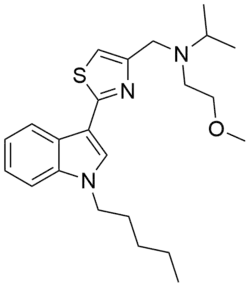PTI-2 |
|
| Legal status |
|
|---|
|
N-(2-methoxyethyl)-N-((2-(1-pentyl-1H-indol-3-yl)thiazol-4-yl)methyl)propan-2-amine
|
| CAS Number | |
|---|
| PubChem CID | |
|---|
| ChemSpider | |
|---|
| UNII | |
|---|
|
| Formula | C23H33N3OS |
|---|
| Molar mass | 399.60 g·mol−1 |
|---|
| 3D model (JSmol) | |
|---|
CCCCCN1C=C(C2=CC=CC=C21)C3=NC(CN(C(C)C)CCOC)=CS3
|
InChI=1S/C23H33N3OS/c1-5-6-9-12-26-16-21(20-10-7-8-11-22(20)26)23-24-19(17-28-23)15-25(18(2)3)13-14-27-4/h7-8,10-11,16-18H,5-6,9,12-15H2,1-4H3 Key:PSAKYYVEVVAWJL-UHFFFAOYSA-N
|
PTI-2 (SGT-49) is an indole-based synthetic cannabinoid.[1] It is one of few synthetic cannabinoids containing a thiazole group and is closely related to PTI-1. These compounds may be viewed as simplified analogues of indole-3-heterocycle compounds originally developed by Organon and subsequently further researched by Merck.[2][3][4]
See also
References
- ^ "PTI-2". Cayman Chemical. Retrieved 8 July 2015.
- ^ US 7700634, Adam-Worrall J, Morrison AJ, Wishart G, Kiyoi T, McArthur DR, "(Indol-3-yl) heterocycle derivatives as agonists of the cannabinoid CB1 receptor.", issued 20 April 2010, assigned to Organon NV
- ^ US 7763732, Paul David Ratcliffe PD, Adam-Worrall J, Morrison AJ, Francis SJ, Kiyoi T, "Indole Derivatives", issued 27 July 2010, assigned to Organon NV
- ^ Kiyoi T, Adam JM, Clark JK, Davies K, Easson AM, Edwards D, et al. (March 2011). "Discovery of potent and orally bioavailable heterocycle-based cannabinoid CB1 receptor agonists". Bioorganic & Medicinal Chemistry Letters. 21 (6): 1748–53. doi:10.1016/j.bmcl.2011.01.082. PMID 21316962.
|
|---|
Phytocannabinoids
(comparison) | | Cannabibutols | |
|---|
| Cannabichromenes | |
|---|
| Cannabicyclols | |
|---|
| Cannabidiols | |
|---|
| Cannabielsoins | |
|---|
| Cannabigerols | |
|---|
| Cannabiphorols | |
|---|
| Cannabinols |
- CBN
- CBNA
- CBN-C1
- CBN-C2
- CBN-C4
- CBNM
- CBND
- CBNP
- CBVD
|
|---|
| Cannabitriols | |
|---|
| Cannabivarins | |
|---|
| Delta-3-tetrahydrocannabinols | |
|---|
| Delta-4-tetrahydrocannabinols | |
|---|
| Delta-7-tetrahydrocannabinols | |
|---|
| Delta-8-tetrahydrocannabinols | |
|---|
| Delta-9-tetrahydrocannabinols | |
|---|
| Delta-10-Tetrahydrocannabinols | |
|---|
| Delta-11-Tetrahydrocannabinols | |
|---|
| Miscellaneous cannabinoids | |
|---|
| Active metabolites | |
|---|
|
|---|
| Endocannabinoids | |
|---|
Synthetic
cannabinoid
receptor
agonists /
neocannabinoids | Classical cannabinoids
(dibenzopyrans) | |
|---|
Non-classical
cannabinoids | |
|---|
| Adamantoylindoles | |
|---|
| Benzimidazoles | |
|---|
| Benzoylindoles | |
|---|
| Cyclohexylphenols | |
|---|
| Eicosanoids | |
|---|
Indazole-3-
carboxamides | |
|---|
| Indole-3-carboxamides | |
|---|
| Indole-3-carboxylates | |
|---|
| Naphthoylindazoles | |
|---|
| Naphthoylindoles | |
|---|
| Naphthoylpyrroles | |
|---|
| Naphthylmethylindenes | |
|---|
| Naphthylmethylindoles | |
|---|
| Phenylacetylindoles | |
|---|
| Pyrazolecarboxamides | |
|---|
Tetramethylcyclo-
propanoylindazoles | |
|---|
Tetramethylcyclo-
propanoylindoles | |
|---|
| Others | |
|---|
|
|---|
| Allosteric CBRTooltip Cannabinoid receptor ligands | |
|---|
Endocannabinoid
enhancers
(inactivation inhibitors) | |
|---|
Anticannabinoids
(antagonists/inverse
agonists/antibodies) | |
|---|
|
|
|---|
Receptor
(ligands) | | CB1Tooltip Cannabinoid receptor type 1 | Agonists
(abridged,
full list) | |
|---|
| Inverse agonists | |
|---|
| Antagonists | |
|---|
|
|---|
| CB2Tooltip Cannabinoid receptor type 2 | | Agonists |
- 2-AG
- 2-AGE (noladin ether)
- 3,3'-Diindolylmethane
- 4-O-Methylhonokiol
- α-Amyrin · β-Amyrin
- A-796,260
- A-834,735
- A-836,339
- AM-1172
- AM-1221
- AM-1235
- AM-1241
- AM-2232
- Anandamide
- AZ-11713908
- Cannabinol
- Caryophyllene
- CB-13
- CBS-0550
- CP 55,940
- GW-405,833 (L-768,242)
- GW-842,166X
- HU-308
- JTE 7-31
- JWH-007
- JWH-015
- JWH-018
- JWH-73
- JWH-133
- L-759,633
- L-759,656
- Lenabasum (anabasum)
- Magnolol
- MDA-19
- Nabitan
- NADA
- Olorinab (APD-371)
- PF-03550096
- S-444,823
- SER-601
- Serinolamide A
- UR-144
- Tedalinab
- THC (dronabinol)
- THCV
- Tetrahydromagnolol
- Virodhamine
|
|---|
| Antagonists | |
|---|
|
|---|
NAGly
(GPR18) | |
|---|
| GPR55 | |
|---|
| GPR119 | |
|---|
|
|---|
Transporter
(modulators) | | eCBTsTooltip Endocannabinoid transporter | |
|---|
|
|---|
Enzyme
(modulators) | | FAAHTooltip Fatty acid amide hydrolase | |
|---|
| MAGL | |
|---|
| ABHD6 |
- Inhibitors: JZP-169
- JZP-430
- KT182
- KT185
- KT195
- KT203
- LEI-106
- ML294
- ML295
- ML296
- UCM710
- WWL-70
|
|---|
| ABHD12 | |
|---|
|
|---|
| Others |
- Others: 2-PG (directly potentiates activity of 2-AG at CB1 receptor)
- ARN-272 (FAAH-like anandamide transporter inhibitor)
|
|---|
- See also
- Receptor/signaling modulators
- Cannabinoids (cannabinoids by structure)
|
